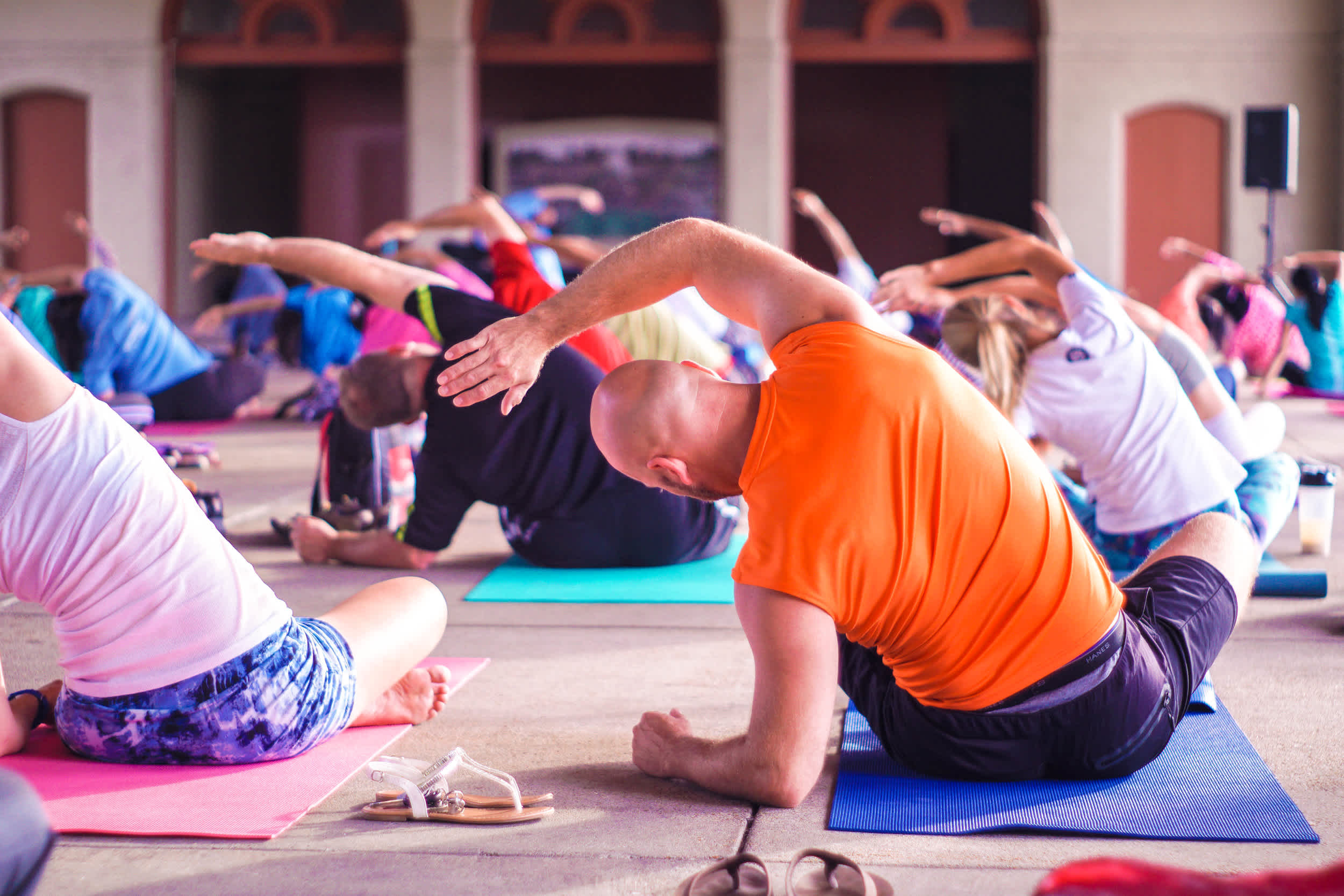Movement is medicine: why exercise therapy reduces chronic pain
Millions of people suffering from chronic musculoskeletal (MSK) pain find it tempting to avoid the motions that cause pain. But exercise actually retrains the brain and body to manage pain and is often the very best way to help lessen the pain.
- Hinge Health Learning Center
- Articles
- Movement is medicine: why exercise therapy reduces chronic pain
Our Hinge Health Experts
Meghan Doherty
Have you ever been in so much pain that you just didn’t want to move?
That was the case with Brian (name changed), a 43 year old Heavy Equipment Operator at a ski resort who suffered from daily back pain from a herniated disk. Waking up on a Saturday morning after a long week of work, he groaned in pain as he slowly tried to get out of bed only to immediately lay back down to rest. He knew he would have to get up eventually but dreaded the pain that would come with moving his back. Once an avid snowboarder and hiker, he found himself being less and less active and would spend days in bed when the pain was at its worst. Even the smallest movements seemed to trigger his pain which was becoming worse over time, and he had resigned himself to a sedentary lifestyle.
Like Brian, millions of people suffering from chronic musculoskeletal (MSK) pain find it tempting to avoid the motions that cause pain. But exercise actually retrains the brain and body to manage pain and is often the very best way to help lessen the pain, avoid surgery and drugs, and improve quality of life. In fact, all the leading medical bodies recommend preventative non-invasive MSK care before drugs & surgery.
The 3 pillars of best practice preventative care for MSK pain are: exercise therapy, behavioral health, and education.
With reducing high MSK spend being a top priority for benefits professionals, many employers are looking for innovative ways to help their members avoid surgery and drugs stemming from these conditions. By understanding the 3 pillars of best practice care, employers can find solutions that deliver better clinical outcomes and reduce medical costs, while also positively impacting absenteeism and mental health in their workforce.
In this blog series, we will explain how each of the pillars work to make lasting improvements for those suffering from chronic MSK pain, starting with exercise therapy.
Chronic Pain Causes Avoidance of Physical Activity
According to the Fear Avoidance Model, people with chronic pain avoid physical activity because they think that it will make their pain worse. This behavior leads to decreased levels of physical activity which actually worsens pain, as muscles atrophy, mobility becomes more limited, and you become more sensitive to pain. This negative feedback loop of chronic pain and inactivity can be a difficult cycle to break.
Chronic pain is also highly correlated to depression. Depression has a feedback loop that increases the severity and intensity of pain, and chronic MSK pain increases the risk for depression. This is called the depression-pain dyad. Tiredness, lack of energy, and loss of interest in normal activities are often symptoms of depression, which contribute to the avoidance of physical activity.
Chronic Pain Makes You Oversensitive to Pain
To understand how exercise therapy helps treat chronic pain, it’s important to first examine how chronic pain affects the pain system. Pain is always created and processed by the brain. Essentially it’s the body’s alarm system and a protective response. Sometimes the pain system goes a little haywire, like a computer that’s been infected with a bug. Problems can arise when the pain buffer zone, the threshold between where you begin to feel pain and when actual damage can occur, fails to readjust. This means that you are feeling pain even though you are far from risking damage.
As a result, the pain warning system stays ultra sensitive – like a car alarm that keeps going off to the wind instead of an intruder. This is how chronic pain changes how your brain perceives pain. When your body feels a certain pain repeatedly, such as Brian and his chronic back pain, it requires less stimulus to trigger the pain. The body becomes more efficient at producing pain – it can actually learn pain.
Exercise Helps You Manage Chronic Pain
When you’re in pain, it’s tempting to take it easy to avoid further damage. This is unlikely to help – quite the reverse in fact. Not moving enough often causes a cascade of factors that can amplify pain. Exercise is actually the best way to retrain an overprotective pain system. Stretching and strengthening exercises can retrain the pain system and readjust the pain buffer zone, reminding it that movement is normal and ‘safe’. Another added benefit is that exercise releases endorphins, which can actually block pain signals from reaching the brain.
Getting started with exercise therapy is often the hardest part due to the way chronic pain can affect your state of mind, behaviors and beliefs. This is where the other 2 pillars of best practice care come in. Education is important for understanding how pain works and realizing that hurt doesn’t always mean harm. Behavioral therapy helps dissuade pain behaviors that reinforce disability and pain, such as inactivity.
Exercise Has Health Benefits Beyond Managing MSK Pain
Exercise helps you regain strength, flexibility, and energy. When we move, our bodies create substances that help our joints, discs, and even our lungs stay lubricated so they move smoothly. By making muscles and joints work harder than usual, it conditions them to loosen and improves mobility and strength.
Exercise improves overall health because pain contributors also impact your overall health. Arguably, one of the most important benefits of exercise is that it improves mental well-being by improving sleep, increasing resilience to stress, improving confidence, and reducing fear of movement. Exercise is also proven to alleviate symptoms of depression. The improved blood and oxygen flow from exercise can also have a positive impact on cardiovascular health.
Conclusion
Beyond some of the more obvious health benefits, exercise therapy is critical to best practice MSK care because it actually retrains the brain to better manage pain. As employers evaluate programs to address the high cost of MSK pain in their workforce, they should consider that any program for MSK care should include exercise therapy. However, that itself is not enough. By delivering a program founded on the 3 pillars of best practice care, employers can dramatically reduce the need for surgery and drugs while helping their members stop their pain from impacting their work and leisure.
Remember Brian? His employer, Vail Resorts, implemented Hinge Health, a digital MSK care program based on the 3 pillars of best practice care: Education, Behavioral Health, and Exercise Therapy. He was surprised to see that he wasn’t alone in suffering from chronic MSK pain, with nearly 1000 employees enrolled in the program. After completing the 12 week program, on average, participants experienced:
Nearly 60% reduction in pain
1 in 2 surgeries avoided
70%+ reduction in depression and anxiety
Although he was skeptical at first, after incorporating exercise therapy into his routine as a part of the best practice care he received, Brian was able to hike over 10 miles in steep terrain with a backpack on without any pain, missing any work days, or spending any days in bed. His pain is no longer triggered by getting out of bed in the morning and he can hit the slopes again without any fear of pain, demonstrating that for chronic pain, movement really is medicine.
###Want to learn more about the 3 pillars? View the webinar to hear the full story of how Vail Resorts reduced MSK spend and helped their workforce overcome chronic MSK pain through best practice care.
Contributing Writers:
Christine Binko
References:
Understanding and Managing Long Term Pain, British Pain Society. Downloaded 2.5.18
Tame the Beast, Questions. Downloaded 2.5.18
Bair MJ, Robinson RL, Katon W, Kroenke K. Depression and Pain Comorbidity; A Literature Review. Arch Intern Med. 2003; 163(20): 2433–2445. doi:10.1001/archinte.163.20.2433.
Parker, R., Bergman, E., Mntambo, A., Stubbs, S. & Wills, M., 2017, ‘Levels of physical activity in people with chronic pain’, South African Journal of Physiotherapy 73(1), a323.
Leeuw M., Goossens M.E., Linton S.J., Crombez G., Boersma K. & Vlaeyen J.W., 2007, ‘The fear-avoidance model of musculoskeletal pain: Current state of scientific evidence’, Jouranl of Behavioral Medicine 30, 77–94. 10.1007/s10865-006-9085-0
Moen, D., & Foster, F. 2019. Permission to Move. Australia: Permission To Move Pty Ltd.

